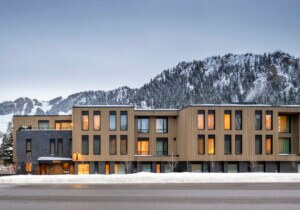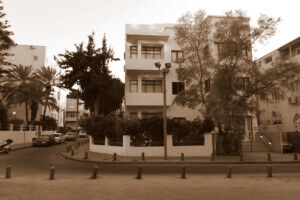The Getty Foundation has unveiled the beneficiaries of this year’s Keeping It Modern architectural conservation grant initiative, a program run by the foundation that aims to support projects of “outstanding architectural significance.”
The grants are awarded to ongoing conservation projects that promise to “advance conservation practice” with regard to modern and contemporary architectural relics. According to the foundation, many modern and contemporary works of architecture were built using experimental materials, untested building strategies, or were repaired badly over the decades. Consequently, contemporary preservation and stabilization strategies are urgently needed to prepare many modern structures for the future.
The grant initiative, which began in 2014, mostly focuses on providing funding for research and study purposes. It aims to fill in funding gaps for threatened structures, allowing their owners and operators to commission preservation, structural, or renovation studies. The initiative has afforded 45 such grants since its inception.
This year’s buildings span the globe and includes works in Japan, Morocco, India, and Kosovo. Here are the 12 projects that are sharing $1.66 million in grant funding:
Cathedral Church of St. Michael, Coventry Cathedral
Sir Basil Spence
Coventry, England
Built: 1962
Funds Awarded: $174,530
The Coventry Church of St. Michael by Sir Basil Spence was designed in 1962 as part of the post–World War II reconstruction effort in England. The original 500-year-old Gothic church was almost entirely destroyed during the war with only the structure’s outer walls, tower, and spire remaining intact. Spence’s plan called for saving these components and surrounding them with new construction. Spence added red sandstone walls, slender concrete columns, and gentle vaulting to complement the historic character of the original church. The church has been in constant use for over 50 years; The Getty Foundation’s grant will help the current church architect consult with conservation specialists on the creation of a comprehensive conservation management plan for the structure that will allow for repairs to take place.
City of Boston, Boston City Hall
Kallmann McKinnell & Knowles
Boston
Built: 1968
Funds Awarded: $120,000
Boston’s iconic Brutalist city hall was designed by Gerhard Kallmann, Michael McKinnell, and Edward Knowles in 1962. The controversial structure has enjoyed a resurgence of popularity in recent years as Brutalist architecture has come back in vogue. The functioning civic building has suffered over the decades from various types of water infiltration, faulty concrete joinery, and other ailments; however, restoration efforts are currently under way. Grant funding will be used to evaluate the building and its attendant plaza, perform laboratory analysis of the concrete elements, and plan for the long term conservation of the building and its systems.
Fondation Caisse de Dépôt et de Gestion (CDG), Sidi Harazem Thermal Bath Complex
Jean-François Zevaco
Sidi Harazem, Morocco
Built: 1958
Funds Awarded: $150,000
The Sidi Harazem Thermal Bath Complex was built in the years following Moroccan independence from French colonial dominance and represented the new nation’s desire to “create modern and forward-thinking gathering spaces,” according to the Getty Foundation. The Moroccan-born French architect Jean-François Zevaco designed the complex in 1957 as a series of bungalows and a market surrounding a central courtyard. The complex fell into disrepair by the 1980s; these sections have been permanently closed since. The Fondation Caisse de Dépôt et de Gestion—the group that owns the structure—will use Getty funds to create a conservation plan for the site that will guide future interventions with the eventual goal of fully restoring the entire complex.
Japan Sport Council, Yoyogi National Gymnasium
Kenzo Tange
Tokyo, Japan
Built: 1964
Funds Awarded: $150,000
The Yoyogi National Gymnasium was designed in 1964 by Japanese architect Kenzo Tange as part of Japan’s bid to host the first-ever Olympic Games in Asia. The pioneering Metabolist structure is made up of a shell-shaped concrete exoskeleton that curves between the structure’s raked seating assemblies and a large spire. The structure has been continuously in use since and is being readied in preparation for the 2020 Tokyo Olympic Games when it will be used for indoor sports competitions. The grant money will be used to develop one of the first conservation management plans for a modern building in Japan, according to the Getty, and will also go toward studying the building’s materials, possible upgrades, and history.
Middle East Technical University, Faculty of Architecture Building
Altuğ Çinici and Behruz Çinici
Ankara, Turkey
Built: 1963
Funds Awarded: $100,000
The Middle East Technical University Faculty of Architecture Building—located in Ankara and designed by the architect couple Altuğ Çinici and Behruz Çinici in 1963— is considered among the best examples of modern architecture in Turkey. The complex originally housed administrative offices and the university library but was converted in 1966 to house the university’s Faculty of Architecture, though the International Style complex has deteriorated over the years due to its earthquake-prone location. The university will use grant funding to create a prototype restoration and conservation plan for the buildings that can be used to raise public awareness regarding the preservation of Turkey’s modern architecture across the country.
Museu de Arte de São Paulo Assis Chateaubriand (MASP), Museo de Arte de São Paulo Assis Chateaubriand
Lina Bo Bardi
São Paulo, Brazil
Built: 1968
Funds Awarded: $ 150,000
The Museu de Arte de São Paulo Assis Chateaubriand (MASP) is an iconic work of Brazil’s strain of regional modernism by architect Lina Bo Bardi. The museum’s gallery spaces are lifted 26 feet above a large plaza by heroic concrete arches. The 110,000-square-foot building has suffered from water infiltration issues, concrete spalling, and structural problems over the years. Though those concerns have been addressed in previous updates, more work is needed and a long-term plan is lacking. Grant monies will go toward mapping out a long-term conservation approach for the structure that will integrate preservation and maintenance concerns for the building.
NVA (Europe) Limited, St Peter’s Seminary
Andy MacMillan and Isi Metzstein (Gillespie, Kidd & Coia architectural practice)
Glasgow, Scotland
Built: 1966
Funds Awarded: $148,120
Newly-conducted research and visioning have helped to outline a future for Andy MacMillan and Isi Metzstein’s St. Peter’s Seminary in Glasgow, Scotland. The complex has been abandoned since the 1970s and was placed on the World Monuments Fund’s 2008 list of most endangered cultural landmarks. In the years since, a plan to stabilize and convert the rough and geometric Brutalist complex into a performance space, cultural venue, and exhibition center has materialized. Before that can happen, the structure must be cataloged and mapped. Using grant money, researchers will delve into the various states of decay for each of the structure’s pre-cast concrete panels, analyze the building’s structural frame, and perform a series of test repairs and mock-ups to guide the building’s future conservation.
PEC University of Technology, Government Museum and Art Gallery
Le Corbusier (Charles- Édouard Jeanneret)
Chandigarh, India
Built: 1968
Funds Awarded: $150,000
Le Corbusier’s Government Museum and Art Gallery in Chandigarh, India is considered one of the architect’s master works. The structure was developed in partnership with Pierre Jeanneret as a test of their so-called “Museum of Unlimited Growth” concept, a modular approach based on a spiraling nautilus that could be added onto indefinitely. The building is in decent shape but requires long-term repairs to better adapt the structure to its local climate. Grant funding will be used to develop a research-based conservation and management plan that will aim to catalog urgent conservation repairs and establish a maintenance strategy.
Price Tower Arts Center, Price Tower
Frank Lloyd Wright
Bartlesville, Oklahoma
Built: 1956
Funds Awarded: $75,000
Price Tower in Bartlesville, Oklahoma is a 19-story skyscraper designed by architect Frank Lloyd Wright. An early example of the luxury condo tower, the building was first developed to house upscale residential and commercial functions. The building remained in use in its original configuration until 1981 when it was sold to Phillips Petroleum, which converted the structure to office functions. The complex was donated to the Price Tower Arts Center organization in 2002 and has been partially restored and renovated. The building became a National Historic Landmark in 2007; received funds will be used to develop a comprehensive, holistic management plan.
Schusev State Museum of Architecture, Melnikov House
Konstantin Melnikov
Moscow, Russia
Built: 1929
Funds Awarded: $120,000
The Melnikov House designed by Konstantin Melnikov in 1929 as the architect’s family home and studio. The structure is heralded as a key work of the Soviet avant-garde movement in architecture and remained in the architect’s family until 2006. The structure was transferred to the state in 2011 and now operates as a museum containing 14,000 objects. The barreled structure is studded with 64 honeycomb-shaped windows that let soft light into the building’s interiors and are based on principles of structural and material efficiency. The building will soon suffer from its own success—the projected number of visitors to the museum has created long-term preservation issues. Grant funding will aim to address these concerns while also performing technical research on the building’s roof, mechanical, and electrical systems, among other aspects.
Stiftung Bauhaus Dessau, Bauhaus building
Walter Gropius
Dessau, Germany
Built: 1925
Funds Awarded: $160,047
The Dessau Bauhaus building, designed by Walter Gropius in 1925, is one of the most iconic modern structures left in existence. The sprawling structure exemplifies the modern movement’s approach to compartmentalized programming and exhibits a clear structural expression of modern materials like steel, concrete, and ribbon glass. The progressive art and architecture school was named a UNESCO World Heritage Site in 1996 and operates as a museum and research center today. Funding will be directed toward consolidating the site’s historical and technical records into a comprehensive database to “guide and prioritize future interventions,” according to the Getty. This effort will be complemented by efforts to analyze character-defining features like the building’s steel windows, nickel-plated fixtures, and some of the building’s legacy materials.
Universitá degli Studi di Roma “La Sapienza,” Stadio Flaminio
Pier Luigi Nervi
Rome, Italy
Built: 1960
Funds Awarded: $161,000
Pier Luigi Nervi’s Stadio Flaminio is a canonical work of post-World War II modern architecture in Italy. The structurally-expressive, thin-shelled concrete structure was constructed in advance of the 1960 Rome Olympic Games. The 45,000-seat stadium was originally designed for sporting events but was often utilized as a performance and soccer venue as well. It was in use until 2011 when the stadium was decommissioned by the Municipality of Rome. The municipality is currently pursuing a conservation plan for the complex and will aim to study the building’s structural stability and innovative materials.










